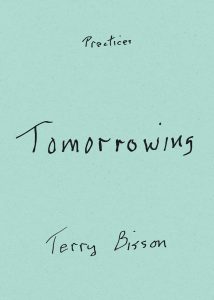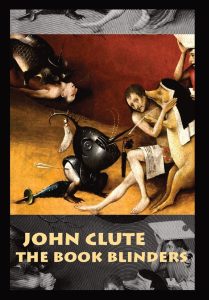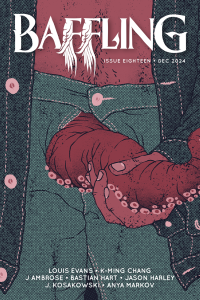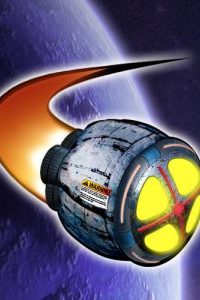SHORT TAKES: Gary K. Wolfe Reviews Tomorrowing by Terry Bisson and The Book Blinders by John Clute
 Tomorrowing, Terry Bisson (Duke University Press 978-1-4780-3068-3, $15.95, 168pp, tp) May 2024.
Tomorrowing, Terry Bisson (Duke University Press 978-1-4780-3068-3, $15.95, 168pp, tp) May 2024.
Terry Bisson, who died in January, began writing his ‘‘This Month in History’’ column of hilarious microfictions for Locus on April Fool’s Day 2004, and for the next two decades it became as much a fixture of this magazine as The New Yorker’s cartoons or Alfred Hitchcock’s cameos. (He’d actually begun a similar series for Eileen Gunn’s Infinite Matrix a few years earlier.) With only four entries per month, few of them more than 50 words in length, it was easy to overlook what Bisson was accreting like a succession of tree rings – possibly ‘‘the longest-running trade magazine fiction feature in the universe,’’ as Bisson himself wrote. In 2023, the series provided the basis for a New Yorker profile by Margret Grebowicz, who, as it turned out, was editing a series for Duke University Press, and now we have Tomorrowing, which collects columns from 2004 through 2023, with a brief introduction by Bisson. It’s a hoot.
Some of these entries are little more than punchy headlines (‘‘China Buys Atmosphere’’, ‘‘Disney-Marvel buys Vatican’’, ‘‘Facebook seeks admission to UN’’, or my favorite, ‘‘APRIL 1, 4132. Universe recalled’’), while others offer lethal satirical darts and still others read like seeds of longer stories or even novels; a few even work as entire microstories, like these:
FEBRUARY 21, 2255. Close call. ErthGaard’s first test of its new time gun prompts loud huzzahs as a deadly asteroid threatening Cozumel is sent back 65 million years.
SEPTEMBER 10, 2054. Burning Man statehood. Ratification celebrations (rat races) erupt at Black Rock City as 51st state prepares to select two senators via art car drags.
Bisson made no effort to arrange his dates into any sort of consistent future history, and some of the older entries inevitably seem dated, but others seem spookily timely, like the first trans woman in the NBA or the first senator to transition while in office. One even takes a crack at Riddley Walker-style futuristic language:
MARRR 09, 15432. Londinium updug. Te reman d’bigbig twonortowns i’dis cover an undug nexcoast of Uropea Guran, prom all happiness forcause London o Londionium
A few feature SF literary in-jokes, like this one:
MAY 18, 2026. This Month in History snags Pulitzer. The award for Historical Fiction is accepted by current editor Gavin Grant, who generously offers to share the honors with the founder of the series, whose name he unfortunately cannot recall.
By now, though, it should be evident that Tomorrowing is all but unreviewable, and for me to go on about it any further would risk turning into that guy in the bar who won’t let you go until you’ve heard just one more favorite. Best to simply check it out for yourself.
 The Book Blinders, John Clute (Norstrilia Press 978-0645369649, $69.00, 504pp, hc) April 2024.
The Book Blinders, John Clute (Norstrilia Press 978-0645369649, $69.00, 504pp, hc) April 2024.
For most readers, it’s probably just as well to think of John Clute’s The Book Blinders as an art book with an argument. Lavishly produced (and lavishly priced) by Australia’s recently revived Norstrilia Press, it makes a persuasive case that the British Library’s practice of discarding the book jackets from its acquisitions has resulted in a scandalous loss of cultural capital for well over a century (the first dust jackets appeared in 1819, we are told). Although Clute doesn’t emphasize it, the same practice by the Library of Congress and most university libraries only exacerbates the problem. For example, Clute notes that apparently no copies survive of the original cover of H.G. Wells’s War of the Worlds, and that (to use a more recent example) the dust jacket of Robert Holdstock’s Lavondyss not only features a lovely Alan Lee wraparound illustration but is the only place in the whole book that tells us it’s a sequel to Mythago Wood. Throughout, Clute gives examples of lost cover art, biographical details, publishing details (such as whether a book is part of a series), blurbs and review quotations, even crucial copyright information. None of this will be news to collectors, who already know how much an intact dust jacket increases a book’s value, but for the general reader it’s worth knowing that such information was, in effect, the metadata of a predigital age, filling in details of a book’s production and marketing that is usually missing from the stripped book itself.
Only about 20 of the 115 examples that Clute lists are genre titles, but since it’s Clute, and since each high-quality illustration is accompanied by a brief essay, you can’t help but learn stuff. The currently popular practice of inviting contemporary authors to re-imagine classic fairy tales, it turns out, dates back to the 1934 anthology The Fairies’ Return, Or New Tales for Old (most of the contributors are women, which is also interesting). The dust jacket of Katherine Burdekin’s Swastika Night (1937) – the first of what would be many Hitler Victorious stories – contains a useful summary of Burdekin’s future history, but nowhere actually mentions that the book is fiction. The flap copy of Eric Frank Russell’s Sinister Barrier (1943) may have been one of the earliest UK uses of the term ‘‘science fiction’’ to promote a book.
Similarly, Naomi Mitchison’s apparently satirical take on the Grail quest, To the Chapel Perilous (1955), sounds absolutely delightful, and almost certainly was one of the first novels to be promoted on the success of The Lord of the Rings, whose third volume was published the same year (and an ad for which takes up the entire back cover of Mitchison’s novel). The first printing of C.S. Lewis’s Till We Have Faces includes a statement by Lewis as to how and why he chose to adapt the Cupid and Psyche myth – but only on the dust jacket. We learn similar tidbits about books by Borges, Kafka, Golding, Moorcock, T.H. White, Ward Moore, Philip Pullman, and Brian Aldiss, among many others. It’s an eminently browsable reminder that the history of books is far more than the history of texts, and as usual even Clute’s offhand comments can be fascinating. Fortunately, for those understandably daunted by the gate admission, a Kindle version is available.
Gary K. Wolfe is Emeritus Professor of Humanities at Roosevelt University and a reviewer for Locus magazine since 1991. His reviews have been collected in Soundings (BSFA Award 2006; Hugo nominee), Bearings (Hugo nominee 2011), and Sightings (2011), and his Evaporating Genres: Essays on Fantastic Literature (Wesleyan) received the Locus Award in 2012. Earlier books include The Known and the Unknown: The Iconography of Science Fiction (Eaton Award, 1981), Harlan Ellison: The Edge of Forever (with Ellen Weil, 2002), and David Lindsay (1982). For the Library of America, he edited American Science Fiction: Nine Classic Novels of the 1950s in 2012, and a similar set for the 1960s. He has received the Pilgrim Award from the Science Fiction Research Association, the Distinguished Scholarship Award from the International Association for the Fantastic in the Arts, and a Special World Fantasy Award for criticism. His 24-lecture series How Great Science Fiction Works appeared from The Great Courses in 2016. He has received six Hugo nominations, two for his reviews collections and four for The Coode Street Podcast, which he has co-hosted with Jonathan Strahan for more than 300 episodes. He lives in Chicago.
This review and more like it in the August 2024 issue of Locus.
While you are here, please take a moment to support Locus with a one-time or recurring donation. We rely on reader donations to keep the magazine and site going, and would like to keep the site paywall free, but WE NEED YOUR FINANCIAL SUPPORT to continue quality coverage of the science fiction and fantasy field.
©Locus Magazine. Copyrighted material may not be republished without permission of LSFF.






